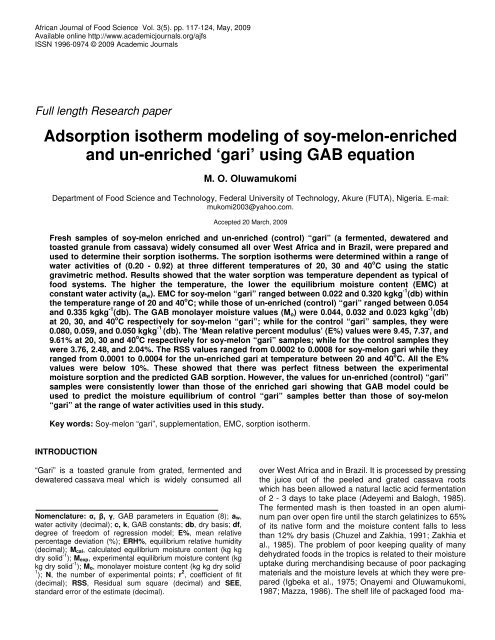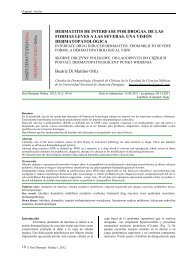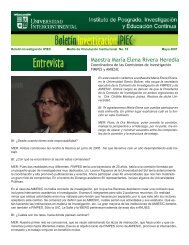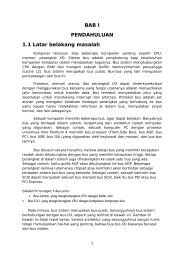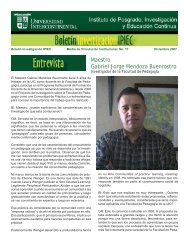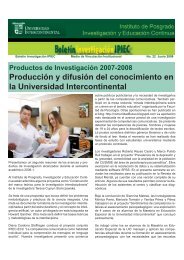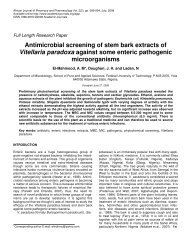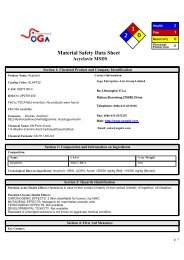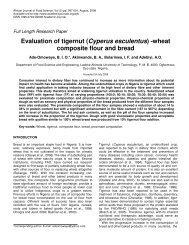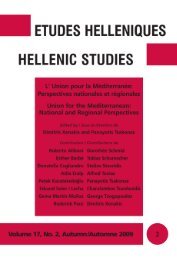Adsorption isotherm modeling of soy-melon ... - Science Stage
Adsorption isotherm modeling of soy-melon ... - Science Stage
Adsorption isotherm modeling of soy-melon ... - Science Stage
You also want an ePaper? Increase the reach of your titles
YUMPU automatically turns print PDFs into web optimized ePapers that Google loves.
African Journal <strong>of</strong> Food <strong>Science</strong> Vol. 3(5). pp. 117-124, May, 2009Available online http://www.academicjournals.org/ajfsISSN 1996-0974 © 2009 Academic JournalsFull length Research paper<strong>Adsorption</strong> <strong>isotherm</strong> <strong>modeling</strong> <strong>of</strong> <strong>soy</strong>-<strong>melon</strong>-enrichedand un-enriched ‘gari’ using GAB equationM. O. OluwamukomiDepartment <strong>of</strong> Food <strong>Science</strong> and Technology, Federal University <strong>of</strong> Technology, Akure (FUTA), Nigeria. E-mail:mukomi2003@yahoo.com.Accepted 20 March, 2009Fresh samples <strong>of</strong> <strong>soy</strong>-<strong>melon</strong> enriched and un-enriched (control) “gari” (a fermented, dewatered andtoasted granule from cassava) widely consumed all over West Africa and in Brazil, were prepared andused to determine their sorption <strong>isotherm</strong>s. The sorption <strong>isotherm</strong>s were determined within a range <strong>of</strong>water activities <strong>of</strong> (0.20 - 0.92) at three different temperatures <strong>of</strong> 20, 30 and 40 o C using the staticgravimetric method. Results showed that the water sorption was temperature dependent as typical <strong>of</strong>food systems. The higher the temperature, the lower the equilibrium moisture content (EMC) atconstant water activity (a w ). EMC for <strong>soy</strong>-<strong>melon</strong> “gari” ranged between 0.022 and 0.320 kgkg -1 (db) withinthe temperature range <strong>of</strong> 20 and 40 o C; while those <strong>of</strong> un-enriched (control) “gari” ranged between 0.054and 0.335 kgkg -1 (db). The GAB monolayer moisture values (M o ) were 0.044, 0.032 and 0.023 kgkg -1 (db)at 20, 30, and 40 o C respectively for <strong>soy</strong>-<strong>melon</strong> “gari”; while for the control “gari” samples, they were0.080, 0.059, and 0.050 kgkg -1 (db). The ‘Mean relative percent modulus’ (E%) values were 9.45, 7.37, and9.61% at 20, 30 and 40 o C respectively for <strong>soy</strong>-<strong>melon</strong> “gari” samples; while for the control samples theywere 3.76, 2.48, and 2.04%. The RSS values ranged from 0.0002 to 0.0008 for <strong>soy</strong>-<strong>melon</strong> gari while theyranged from 0.0001 to 0.0004 for the un-enriched gari at temperature between 20 and 40 o C. All the E%values were below 10%. These showed that there was perfect fitness between the experimentalmoisture sorption and the predicted GAB sorption. However, the values for un-enriched (control) “gari”samples were consistently lower than those <strong>of</strong> the enriched gari showing that GAB model could beused to predict the moisture equilibrium <strong>of</strong> control “gari” samples better than those <strong>of</strong> <strong>soy</strong>-<strong>melon</strong>“gari” at the range <strong>of</strong> water activities used in this study.Key words: Soy-<strong>melon</strong> “gari”, supplementation, EMC, sorption <strong>isotherm</strong>.INTRODUCTION“Gari” is a toasted granule from grated, fermented anddewatered cassava meal which is widely consumed allNomenclature: , , , GAB parameters in Equation (8); a w,water activity (decimal); c, k, GAB constants; db, dry basis; df,degree <strong>of</strong> freedom <strong>of</strong> regression model; E%, mean relativepercentage deviation (%); ERH%, equilibrium relative humidity(decimal); M cal, calculated equilibrium moisture content (kg kgdry solid -1 ); M exp, experimental equilibrium moisture content (kgkg dry solid -1 ); M o, monolayer moisture content (kg kg dry solid -1 ); N, the number <strong>of</strong> experimental points; r 2 , coefficient <strong>of</strong> fit(decimal); RSS, Residual sum square (decimal) and SEE,standard error <strong>of</strong> the estimate (decimal).over West Africa and in Brazil. It is processed by pressingthe juice out <strong>of</strong> the peeled and grated cassava rootswhich has been allowed a natural lactic acid fermentation<strong>of</strong> 2 - 3 days to take place (Adeyemi and Balogh, 1985).The fermented mash is then toasted in an open aluminumpan over open fire until the starch gelatinizes to 65%<strong>of</strong> its native form and the moisture content falls to lessthan 12% dry basis (Chuzel and Zakhia, 1991; Zakhia etal., 1985). The problem <strong>of</strong> poor keeping quality <strong>of</strong> manydehydrated foods in the tropics is related to their moistureuptake during merchandising because <strong>of</strong> poor packagingmaterials and the moisture levels at which they were prepared(Igbeka et al., 1975; Onayemi and Oluwamukomi,1987; Mazza, 1986). The shelf life <strong>of</strong> packaged food ma-
118 Afr. J. Food Sci.terials has been shown to be influenced by the temperature,relative humidity and moisture content and thus thewater activity (a w ) <strong>of</strong> the material (Iglesias and Chirife,1976). The relationship between water activity and moisturecontent <strong>of</strong> a food-stuff is important in predicting qualitystability during storage and the selection <strong>of</strong> appropriatepackaging materials for retail purposes (Igbeka,1982). The moisture levels at which some dehydratedfoods have good storage stability have been found toagree closely with the moisture levels calculated from thesorption <strong>isotherm</strong> at different ambient temperature andRH% (Igbeka and Nwachukwu, 1983; Mazza, 1986).Some studies have been carried out on the sorption <strong>isotherm</strong><strong>of</strong> Cassava products such as “gari” (Chuzel andZakhia, 1991), “lafun” (Onayemi and Oluwamukomi,1987), Instant cassava flour (Oluwamukomi, 1999), “fufu”(Sanni et al., 1997), “lafun” and Tapioca (Kuye and Sanni,2002).However there is dearth <strong>of</strong> information on sorption <strong>isotherm</strong><strong>of</strong> many African food products and specifically proteinenriched cassava products. A knowledge and understanding<strong>of</strong> such information on the optimum moisture levels,which should be arrived at during manufacture andfor selection <strong>of</strong> good packaging material is <strong>of</strong> great importancein order to avoid their quality deterioration duringstorage. The water sorption <strong>isotherm</strong> <strong>of</strong> foods is therefore<strong>of</strong> great importance. Many empirical relationships describingthe sorption characteristics <strong>of</strong> food such as Hasley(1948), Henderson (1952), Chung Pfost (1967), Oswin(1946), B.E.T (1938), Langmuir (1940), Smith (1947),Caurie (1970); and the three-parameter GAB model (Wolfet al., 1985; van de Berg, 1984). These models were chosenbecause <strong>of</strong> their suitability for high carbohydratefoods, application over a wide range <strong>of</strong> water activities,simplicity, and ease <strong>of</strong> evaluation (Ajisegiri et al., 2007;Oluwamukomi, 2008). GAB (Guggenheim-Anderson-DeBoer) model has been applied most successfully to describefood <strong>isotherm</strong>s up to a w <strong>of</strong> 0.9 (Van de Berg andBruin, 1981, Iglesias and Chirife, 1976; Labuza et al.,1985) and this has also been recommended by the EuropeanProject Group COST 90 on the Physical Properties<strong>of</strong> Foods as the fundamental equation for the characterization<strong>of</strong> water sorption <strong>of</strong> food materials (Wolf et al.,1985).The objective <strong>of</strong> this study therefore is to subject <strong>soy</strong><strong>melon</strong>protein enriched and un-enriched (control) “gari” tosorption <strong>isotherm</strong> study in order to determine if GABsorption model could be used to describe the sorption behavior<strong>of</strong> the two samples.MATERIALS AND METHODSSamples <strong>of</strong> <strong>soy</strong>-<strong>melon</strong> “gari” were produced according to the methods<strong>of</strong> Oluwamukomi (2006) and Banjoh Ikenebomeh (1996).The Cassava tubers were peeled manually with a sharp knife,washed and grated in a locally fabricated mechanical grater drivenby a powered system (7 hp) (Agunbiade, 2001). The cassava mashObtained was allowed to ferment for 72 h after which it was pressedin a mechanical press (Addis Engineering Nigeria Ltd., Nigeria) todewater the mash (Agunbiade, 2001; Adeyemi and Balogh, 1984,1985). The dewatered wet meal was pulverized and enriched withfull fat <strong>soy</strong>-<strong>melon</strong> supplement at 15% enrichment level and takinginto consideration the water content <strong>of</strong> the mash <strong>of</strong> 65% (Akingbalaet al., 1993). It was then toasted in a wide iron pan (garifier) beingheated over wood fire (Adeyemi and Balogh, 1984, 1985). Thetoasted and cooled <strong>soy</strong>-<strong>melon</strong> “gari” samples were then packagedin HDPE film and kept under refrigerated storage until ready for furtheranalysis.A static gravimetric method was used for the experiment (Greenspan,1977; Wolf et al., 1985). Duplicate samples, 3 ± 0.001 g each,<strong>of</strong> <strong>soy</strong>-<strong>melon</strong> and control “gari” were placed in Petri dishes inside 6desicators containing saturated salt solutions (KC 2H 3O 2, MCl 2,K 2CO 3, MNO 3, NaCl, KCl) providing constant relative humidity environmentsranging from 23 – 92% (Rockland, 1960; Labuza et al.,1985). The sample had been pre-dried in a desiccator with P 2O 5 atroom temperature for 15 days. At high relative humidity (a w > 0.7),toluene (1.5 ml) was placed in the desiccators to prevent microbialgrowth (Labuza, 1984; Kumar and Mishra, 2004). The desiccatorswere kept in temperature controlled cabinets at constant temperatures<strong>of</strong> 20, 30 and 40°C. The samples were weighed at intervals <strong>of</strong>3 days using a digital balance (Model Mettler PE1600, Mettler InstrumentsCorporation, Greifensee, Zurich, Switzerland) with an accuracy<strong>of</strong> 0.1 mg until constant weighs were obtained after threeconsecutives recordings, when the samples were assumed to be atequilibrium (± 0.001 g). The bone dry mass was determined by theoven-drying method for 8 – 10 h at 105 – 110°C (AOAC, 1990). Thetime to reach equilibrium ranged from 15 to 30 day depending onthe water activity in each desiccator with those at higher water activitiesreaching equilibrium faster than those at lower water activities.The equilibrium moisture contents were calculated from whichthe moisture sorption <strong>isotherm</strong>s were determined. The data for thewater adsorption were fitted to the GAB equation to describe theirmoisture adsorption using the GAB equation (Equation 1) (Van deBerg and Bruin, 1981).Theory <strong>of</strong> GAB equationThe GAB equation can be expressed as follows (Van de Berg,1984; Labuza et al., 1985):MeckMoaw=( 1−kaw)(1 − kaw+ ckaw)(1)The three parameters <strong>of</strong> GAB values <strong>of</strong> c, k and M o were derivedfrom the second order polynomial form (equation 2) which was solvedby multi-linear regression analysis to obtain , , , r 2 and RSS(Jouppila and Roos, 1997; Abramovi and Kl<strong>of</strong>utar, 2002; Xion,2002):a w= 2w wMeα a + βa+ γWhere; = k/M o(1/c – 1) = 1/ M o(1 - 2/c) = 1/ M okc(2)The values <strong>of</strong> parameters , , and were obtained for eachtemperature through the following relations:1M =(3)o( β 2 − 4αγ )
Oluwamukomi 119Table 1. Equilibrium moisture contents (Me cal) (kgkg -1 db) for <strong>soy</strong>-<strong>melon</strong> enriched and un-enriched (control) “gari”stored at 20, 30 and 40 o C.Soy-<strong>melon</strong> enriched “gari”Un-enriched (Control) “gari”20ºC 30ºC 40ºC 20ºC 30ºC 40ºC0.23 0.040±0.002 0.023±0.001 0.022±0.003 0.084±0.003 0.066±0.001 0.054±0.0020.35 0.061±0.001 0.035±0.002 0.032±0.004 0.107±0.002 0.073±0.001 0.066±0.0030.45 0.081±0.002 0.045±0.003 0.040±0.002 0.130±0.004 0.096±0.003 0.086±0.0020.61 0.084±0.002 0.052±0.004 0.041±0.002 0.153±0.003 0.109±0.003 0.100±0.0030.75 0.120±0.001 0.105±0.006 0.080±0.004 0.190±0.002 0.148±0.004 0.141±0.0030.92 0.320±0.003 0.170±.005 0.150±0.004 0.335±0.005 0.231±0.004 0.216±0.004Table 2. Experimental (Me exp) and GAB equilibrium moisture contents(Me cal) (kgkg -1 db) for <strong>soy</strong>-<strong>melon</strong> “gari” stored at 20, 30, and 40 o C.Temperature <strong>of</strong>storage20 o C 30 o C 40 o CWater activity (a w) Me (exp) Me (cal) Me (exp) Me (cal) Me (exp) Me (cal)0.23 0.040±0.002 0.0431±0.003 0.023±0.001 0.0239±0.002 0.022±0.003 0.0239±0.0010.35 0.061±0.001 0.0554±0.002 0.035±0.002 0.0342±0.001 0.032±0.004 0.0301±0.0020.45 0.081±0.002 0.0770±0.001 0.045±0.003 0.0436±0.002 0.040±0.002 0.0362±0.0030.61 0.084±0.002 0.0930±0.002 0.052±0.004 0.0633±0.003 0.041±0.002 0.0501±0.0020.75 0.120±0.001 0.1036±0.003 0.105±0.006 0.0915±0.004 0.080±0.004 0.0723±0.0050.92 0.320±0.003 0.3457±0.002 0.170±.005 0.1700±0.002 0.150±0.004 0.1412±0.0032( β − 4αγ)2c =(4)− β +( β − 4αγ)( β2 − 4αγ)− β +k =(5)2αγM o is the monolayer moisture content, c is a constant related tothermal effects and k is the constant related to the properties <strong>of</strong>multilayer water molecules with respect to the bulk liquid. TheseGAB constants M o, c, and k values were fitted into the GAB equation(1) resulting in predicted GAB equilibrium moisture content(M e) (cal) values obtained over the range <strong>of</strong> water activities (0.23 -0.92) used for this study. The GAB equilibrium moisture contents(M e(cal)) and the experimental equilibrium moisture contents (Me (exp))were compared to determine its fitness to describe the sorption <strong>isotherm</strong>s<strong>of</strong> the samples.The quality <strong>of</strong> fitness <strong>of</strong> the GAB model were evaluated by calculatingthe “Mean relative percent deviation modulus” (%E), thestandard error <strong>of</strong> estimate (SEE) (Lomauro et al., 1985; Chen andMorey, 1989) and Coefficient <strong>of</strong> determination (r 2 ) (Akanbi et al.,2006) and the Residual sum <strong>of</strong> squares (RSS) (Sun, 1999) by usingequations (6, 7 and 8) respectively.100% E =NSEE =MexpM− Mexpcal( Mexp− Mcal)df2(6)(7)r2=RSSTSS=( M − M )cal( M − M ) 2expaveave2(8)A “Mean relative percent deviation modulus (%E) <strong>of</strong> less than 10%is an indication that the GAB model is well suited for describing adsorption<strong>isotherm</strong> <strong>of</strong> the sample (Aguerre et al., 1989; Lomauro etal., 1985; Ajibola, 1986b).RESULTS AND DISCUSSIONThe results <strong>of</strong> the determinations <strong>of</strong> the equilibrium moisturecontent at the three temperatures <strong>of</strong> 20, 30 and 40 o Care as shown in Table 1.Fitting <strong>of</strong> GAB sorption model to the experimentalsorption dataThe results <strong>of</strong> the fitting <strong>of</strong> the GAB equations to the experimentaldata in Table 1 are shown in Table 2 while theGAB model <strong>isotherm</strong> curves are shown in Figures 1 and2. The coefficients, , , and <strong>of</strong> the regression equation<strong>of</strong> the GAB model obtained from the <strong>isotherm</strong> plots (Figures1 and 2) are shown in Table 3; while the GAB constantsM o , c, and k values obtained are also shown in theTable 3. The calculated equilibrium moisture content,Me (cal) compared and fitted to the experimental sorptiondata, Me (exp) to determine if GAB model can be used todescribe the sorption behavior <strong>soy</strong>-<strong>melon</strong> “gari” over
120 Afr. J. Food Sci.Table 3. GAB constants (k, c and M o), E%, SEE, r 2 and RSS values for <strong>soy</strong>-<strong>melon</strong> enriched and control (un-enriched) “gari” stored at 20, 30,and 40 o C.Sample Temperature <strong>of</strong> storage k c M o (kgkg -1 db) SEE E% r 2 RSSSoy-<strong>melon</strong>enriched “gari”Un-enriched(Control) “gari”20 o C 0.909 13.09 0.044 0.012 9.45 0.968 0.000230 o C 0.900 5.76 0.032 0.009 7.37 0.942 0.000340 o C 0.916 14.57 0.023 0.006 9.61 0.907 0.000820 o C 0.804 44.06 0.080 0.009 3.76 0.936 0.000130 o C 0.811 38.64 0.059 0.004 2.48 0.964 0.000240 o C 0.816 13.93 0.050 0.003 2.04 0.983 0.0004161412(20 o C) = -9.773 2 + 11.883 + 0.3515R 2 = 0.6936(30 o C)= -13.418 2 + 16.114 + 0.5425R 2 = 0.9007(40 o C)= -12.789 2 + 14.741 + 1.5436R 2 = 0.8947765(20 o C) = -9.773 2 + 11.883 + 0.3515R 2 = 0.6936(30 o C)= -13.418 2 + 16.114 + 0.5425R 2 = 0.9007(40 o C)= -12.789 2 + 14.741 + 1.5436R 2 = 0.894710aw/Me86aw/Me43422100 0.2 0.4 0.6 0.8 1a w00 0.2 0.4 0.6 0.8 1awaw/Me(20°C) aw/Me(30°C) aw/Me(40°C)aw/Me(20°C) aw/Me(30°C) aw/Me(40°C)Figure 1. GAB Model Isotherm curve for Soy-Melon “gari” stored at20, 30 and 40 o C.Figure 2. GAB Model Isotherm curve for Control gari at 20, 30 and40 o C.the entire range <strong>of</strong> water activity are shown in Figures 3and 4 for both <strong>soy</strong>-<strong>melon</strong> enriched and un-enriched (control)“gari”.GAB monolayer moisture content (M o ): The GAB monolayervalues (M o ) for <strong>soy</strong>-<strong>melon</strong> enriched “gari” were0.044, 0.032 and 0.023 kgkg -1 (db) at 20, 30, and 40 o Crespectively while for the control “gari” samples, theywere 0.080, 0.059, and 0.050 kgkg -1 (db) at 20, 30 and40 o C respectively. The GAB monolayer moisture values(M o ) obtained were temperature dependent (Wang andBrennan, 1991; Lomauro et al., 1985; Schar and Ruëgg,1985; McLaughlin and Magee, 1998). As the temperatureincreased from 20 to 40 o C, the GAB monolayer moisturecontent (M o ) decreased from 0.044 to 0.023 kgkg -1 (db).For the control “gari”, M o decreased from 0.080 to 0.050kgkg -1 (db) at the same temperatures. A decrease in GABmonolayer moisture content (M o ) with increase in temperaturewas an indication that the absorbed moleculesgained kinetic energy making the attractive forces to beloosened and this allowed some water molecules tobreak away from their sorption sites thus decreasing theequilibrium moisture values (Arevalo-Pinedo et al., 2004;Labuza et al., 1985). The monolayer moisture contentsfor the <strong>soy</strong>-<strong>melon</strong> “gari” ranging from 0.023 - 0.044 kgkg -1(db) at the three temperatures were lower than those <strong>of</strong>the control “gari” ranging from 0.057 - 0.060 kgkg -1 (db).These values were also lower than other similar un-enrichedcassava products such as “fufu” (0.043 - 0.049),tapioca (0.049 - 0.058), unenriched “gari” (0.057 - 0.060)(Kuye and Sanni, 2002; Sanni et al., 1997; Chuzel andZakhia, 1991 respectively). The monolayer moisture con-
Oluwamukomi 121Table 4. Comparison <strong>of</strong> the GAB sorption parameters for un-enriched (control), <strong>soy</strong>-<strong>melon</strong> enriched “gari” withother past findings on similar cassava products (“lafun”, “gari”, “fufu”, and tapioca) at similar temperatures <strong>of</strong>storage.Estimated GABParametersUn-enriched (Control)Soy-<strong>melon</strong> “gari” Un-enriched “gari”*“gari”20 o C 30 o C 40 o C 20 o C 30 o C 40 o C 15 o C 25 o C 35 o C -9.90 -13.41 -12.78 -38.45 -19.54 -5.98 -13.3 -15.1 -14.5 11.802 16.114 14.741 39.14 16.457 2.056 16.0 17.0 15.7 0.407 0.542 1.543 2.855 6.77 6.920 40.2 45.4 94.4r 2 0.936 0.964 0.983 0.96 0.940 0.910 0.989 0.996 0.988SEE 0.009 0.004 0.003 0.012 0.009 0.006 ND ND NDE% 3.759 2.4833 2.04 9.936 7.377 9.611 4.8 3.4 4.6k 0.804 0.811 0.816 0.900 0.909 0.916 0.824 0.869 0.877c 44.061 38.645 13.93 13.090 5.765 14.569 50.4 45.1 20.9Mo(kgkg -1 db) 0.080 0.059 0.050 0.044 0.032 0.023 0.060 0.056 0.057GAB constants “Fufu”** “Lafun”** Tapioca**25 o C 32 o C 45 o C 25 o C 32 o C 45 o C 25 o C 32 o C 45 o Ck 0.6924 0.715 0.661 0.686 0.710 0.665 0.6201 0.528 0.5509c 126 41.11 18.17 99.539 43.256 19.786 27.2 9.203 7.762M o(kgkg -1 db) 0.049 0.045 0.043 0.049 0.045 0.043 0.058 0.064 0.049*Chuzel and Zakhia (1991).**Kuye and Sanni (1997, 2002).0.40.35Me(exp)20°CMe(exp)30°C Me(exp)20°CMe(exp)40°C Me(exp)30°CMe(exp)40°CMe(cal)20°CMe(cal)30°C Me(cal)20°CMe(cal)40°C Me(cal)30°CMe(cal)40°Cmaterials (Labuza et al, 1985; Van den Berg, 1985, Kaymak-Ertekinand Sultanoglu, 2001). These values agreewith literature data for other starchy products (Chuzel andZakhia, 1991, for “gari”, Kuye and Sanni, 2002, for “laun”,Sanni et al., 1997) for “fufu” and tapioca) (Table 3).Me%0.30.250.20.150.10.0500.23 0.35 0.45 0.61 0.75 0.92a wFigure 3. Experimental and GAB fitted data for Control “gari” at 20,30 and 40 o C.contents, M o were less than 0.1 kgkg -1 (db) in all the productswhich was the maximum value reported for foodGAB constants (k and c): The GAB parameters M o , cand k, were shown to be temperature dependent (Table3). Increase in the temperature resulted in either a decreaseor increase in the M o , c and k values (Diosady etal., 1996). For <strong>soy</strong>-<strong>melon</strong> enriched “gari” samples, withincrease in temperature from 20 to 40 o C, M o decreased, cand k increased. For the un-enriched (control) “gari”, astemperature increased, the GAB constant (k) increasedfrom 0.804 to 0.816, while c decreased from 44.06 to13.93. Increase in (k) was an indication that at highertemperature, the multilayer molecules became more entropicwhile a decrease <strong>of</strong> c was an indication <strong>of</strong> more enthalpyand a gain in kinetic energy resulting in the loss <strong>of</strong>more moisture at higher temperature (Diosady et al.,1996). The range <strong>of</strong> values <strong>of</strong> k less than unity (1.0) wasin agreement with the GAB model’s assumption that themultilayer has properties between those <strong>of</strong> the monolayerand bulk liquid. When k = 1, the multilayer has bulk liquidproperties. This is consistent with findings made for similarproducts by Chuzel and Zakhia (1991) for un-enriched“gari”; Sanni et al. (1997) for “fufu” and tapioca Kuye andSanni (2002) for “lafun” (Table 4); Wang and Brennan(1991), Lomauro et al. (1985) and Schar and Ruëgg(1985).However, for the <strong>soy</strong>-<strong>melon</strong> “gari”, there was an initial
122 Afr. J. Food Sci.Me%0.350.30.250.20.150.10.050Me(exp)20°CMe(exp)30°CMe(exp)40°CMe(cal)20°CMe(cal)30°CMe(cal)40°C0.23 0.35 0.45 0.61 0.75 0.92Figure 4. Experimental and GAB fitted data for Soy-<strong>melon</strong> “gari”stored at 20, 30, and 40 o C.decrease in k and c values from 0.909 and 13.090 to0.900 and 5.765 respectively as the temperature was increasedto 30°C but they later increased to 0.916 and14.569 when the temperature was further increased to40°C. This is was a slight deviation from the generaltrend which was supposed to be temperature dependent,and for k to increase while c decreases. This unusual behavioris similar to that <strong>of</strong> canola meal where Diosady etal; 1996) observed that there was a decrease in both kand c as the temperature was increased. The commonbehavior <strong>of</strong> both canola meal and <strong>soy</strong>-<strong>melon</strong> “gari” mighthave been due to their similar properties <strong>of</strong> being an oilyproduct and their differences in composition, preparationand granulation from other non-oily starchy products(Diosady et al., 1996).When the experimental and fitted <strong>isotherm</strong>s were compared,best fits were obtained at a w up to 0.90. The“Mean relative percent deviation modulus (%E) valueswhich are indication <strong>of</strong> goodness <strong>of</strong> fit <strong>of</strong> the GAB datawith those <strong>of</strong> the experimental values were lower thanthan 10%. Generally, a good fit <strong>of</strong> <strong>isotherm</strong> is assumedwhen the E% value is less than 10% (McLaughlin andMagee, 1998). The E% values were 9.45, 7.377, and9.61% at 20, 30 and 40 o C respectively for <strong>soy</strong>-<strong>melon</strong> “gari”samples; while for the control samples they were 3.76,2.48, and 2.04% at the same temperatures. The RSS valuesranged from 0.0002 to 0.0008 for <strong>soy</strong>-<strong>melon</strong> gariwhile it ranged from 0.0001 to 0.0004 for the un- enrichedgari at temperature between 20 and 40 o C (Table 3).These showed that there was perfect fitness between theexperimental moisture sorption data and the predicteda wGAB sorption for both the un-enriched (control) “gari” and<strong>soy</strong>-<strong>melon</strong> “gari” samples. Hence, GAB model is an appropriateand satisfactory model that could be used topredict the moisture sorption properties <strong>of</strong> both <strong>soy</strong>-<strong>melon</strong>enriched and control “gari” at all the water activitiesup to 0.92 used in this study. This is consistent with findingsmade for similar products by Chuzel and Zakhia(1991) for un-enriched “gari”; Sanni et al. (1997) for “fufu”and tapioca Kuye and Sanni (2002) for “lafun” (Table 4);Schar and Ruëgg (1985) for wheat flour; Caden (1988)for several food fibers, De Jong et al. (1996) for wheatgluten; and Diosady et al. (1996) for canola meal. Vanden Berg (1984), McMinn and Magee (1999) and Timmermannet al. (2001) also reported that the GAB modeladequately represented the sorption <strong>isotherm</strong>s <strong>of</strong> potato,wheat starch and starchy materials respectively. In therange <strong>of</strong> water activity 0.35 < a w < 0.9; Al-Muhtaseb et al.(2004) reported GAB model adequately represented thesorption <strong>isotherm</strong>s <strong>of</strong> potato, highly amylopectin andhighly amylose starch.However, when the values <strong>of</strong> both the enriched and unenrichedgari were compared, the values for the un-enriched(control) “gari” were consistently lower than those<strong>of</strong> <strong>soy</strong>-<strong>melon</strong> enriched “gari”. This shows that there was abetter perfect fitness for the un-enriched “gari” than <strong>soy</strong><strong>melon</strong>enriched “gari”. This must have been due to the effect<strong>of</strong> the oil content in the <strong>soy</strong> and <strong>melon</strong> flours whichreduced the sorption capacity <strong>of</strong> the <strong>soy</strong>-<strong>melon</strong> enriched“gari” (Oluwamukomi et al., 2008). This suggests thatcontrol “gari” has more polar sites on its surface than the<strong>soy</strong>-<strong>melon</strong> “gari”, and thus, the energy <strong>of</strong> binding betweenthe water molecules and the surface is higher(Tsami, 1991). This further explains the ability <strong>of</strong> control“gari” to absorb more moisture than <strong>soy</strong>-<strong>melon</strong> “gari” atthose water activity levels. Labuza et al. (1985) also confirmedthis in dehydrated corn and starch meal. Cornmeal had a higher sorption capacity than fish meal whichwas attributed probably because corn meal is predominantlycarbohydrate and has more polar groups whichcontributes to the increase in the sorption capacity inagricultural products (Iglesias and Chirife, 1982; Fasinaet al., 1999).ConclusionWhen the experimental and fitted <strong>isotherm</strong>s were compared,best fits were obtained at a w up to 0.90. All the valueswere below 10% showing that there was perfect fitnessbetween the experimental moisture sorption and thepredicted GAB sorption. Hence, GAB model could beused to predict the moisture equilibrium <strong>of</strong> both <strong>soy</strong>-<strong>melon</strong>enriched and un-enriched (control) “gari” samples atthe range <strong>of</strong> water activities used in this study. However,the values for the un-enriched (control) “gari” were consistentlylower than those <strong>of</strong> <strong>soy</strong>-<strong>melon</strong> enriched “gari”showing that there was a better perfect fitness for the unenriched(control) “gari” than <strong>soy</strong>-<strong>melon</strong> enriched “gari”.
Oluwamukomi 123This must have been due to the effect <strong>of</strong> the oil content inthe <strong>soy</strong> flour which reduced the sorption capacity <strong>of</strong> the<strong>soy</strong>-<strong>melon</strong> enriched “gari”.REFERENCESAbramovi H, Kl<strong>of</strong>utar C (2002). Water adsorption <strong>isotherm</strong>s <strong>of</strong> somemaltodextrin samples. Acta Chim. Slov. 49: 835-844Adeyemi IA, Balogh E (1984). Biotechnology in food processing- Prospectsin Nigeria. Niger. Food J. 2: 2Adeyemi IA, Balogh E (1985). Biotechnology in food processing- Prospectsin Nigeria. Niger. Food J. 3 (3): 33-39.Ajisegiri ES, Chukwu O, Sopade PA. (2007). Moisture sorption Study <strong>of</strong>Locally-Parboiled Rice. AU J. T. 11(2): 86-90Aguerre RJ, Suarez C, Br Viollaz PE (1989). New BET type multilayersorption <strong>isotherm</strong>s. Part II: Modelling water sorption in foods.Lebensm._Wiss. a. Technol. 22: 192-195.Agunbiade SO (2001). Effect <strong>of</strong> fermentation period on the physiccochemicalproperties <strong>of</strong> gari. Bio. Res. Communi. 13(1): 65-71.Ajibola OO (1986b). Desorption <strong>isotherm</strong>s <strong>of</strong> plantain at several temperatures.J. Food Sci. 51(1): 169-171Ajisegiri ES, Sopade PA (1990). Moisture sorption <strong>isotherm</strong> <strong>of</strong> Nigerianmillet at varying temperatures. J. Food Eng. 12: 283-292.Akanbi CT, Adeyemi RS, Ojo A (2006). Drying characteristics and sorption<strong>isotherm</strong> <strong>of</strong> Tomato slices. J. Food Eng. 73: 157-163Akingbala JO, Oguntimehin GB, Bolade MK (1993). Effect <strong>of</strong> unit operations<strong>of</strong> production on the cyanide content and acceptability <strong>of</strong> gari.J. Food Processing and Preservation. 17: 337-380.Al-Mutaseb AH (2004). Water sorption <strong>isotherm</strong>s <strong>of</strong> starch powders.Part 2: Thermodynamic characteristics. J. Food Eng. 62: 135-142AOAC (1990) Official Method <strong>of</strong> analysis. (Helrich, ed.) 15 th edition,.Association <strong>of</strong> Official Analytical Chemists, Arlington, VA. Vol. 1Arevalo-Pinedo AD, Giraldo-Zuniga FL, Santos ZD, Arevalo S,Rosalinda PA (2004). Application <strong>of</strong> Mathematical models <strong>of</strong> two andthree parameters in the prediction <strong>of</strong> sorption <strong>isotherm</strong>s for Inga (Ingaedulis) pulp. Drying 2004-Proceedings <strong>of</strong> the 14th InternationalDrying Symposium (IDS 2004) Sao Paulo, Brazil, 22-25, vol. A. pp.628-633.Brunauer S, Emmett PB, Teller E (1938). <strong>Adsorption</strong> <strong>of</strong> gases in multimolecularlayers. J. Am. Chem. Soc. 60: 309Banjoh NO, Ikenebomeh MJ (1996). Comparison <strong>of</strong> 3 methods for thepreparation <strong>of</strong> Soy “gari” from cassava and <strong>soy</strong>bean mash. J. FoodSci. Technol. 33(4): 440-442.Caden AM (1988). Moisture sorption characteristics <strong>of</strong> several food fibers.J. Food Sci. 53(4): 1150-1155.Caurie M (1970). A new model equation for predicting safe storagemoisture stability <strong>of</strong> dehydrated foods. J. Food Technol. 5: 301-307.Chen C, Morey RV (1989). Comparison <strong>of</strong> four EMC/ERH equations.Transactions <strong>of</strong> the ASAE. 32(3): 983-990Chung DS, Pfost HB (1967). <strong>Adsorption</strong> and desorption <strong>of</strong> water vapourby cereal grains and their products. Part II. Development <strong>of</strong> the general<strong>isotherm</strong> equation. Transactions <strong>of</strong> the American Soc. Agri. Engr.10: 552-555.Chuzel G, Zakhia N (1991). <strong>Adsorption</strong> <strong>isotherm</strong> <strong>of</strong> gari for estimation <strong>of</strong>packaged shelf life. Int. J. Food Sci. Technol. 26: 583-593.De Jong GIW, Van den Berg C, Kokelaar AJ (1996). Water vapor sorptionbehavior <strong>of</strong> original and defatted wheat gluten. lnt. J. Food Sci.Technol. 31: 519-526.Diosady LL, Risvi SSH, Cai W, Jagdeo DJ (1996) Moisture sorptionIsotherms <strong>of</strong> Canola meals, and application to packaging. J. FoodSci. 61(1): 204-208.Fasina OO, Ajibola OO, Tyler RT (1999). Thermodynamics <strong>of</strong> moisturesorption in winged bean seed and gari. J. Food Process Eng. 22:405-418Greenspan L (1977). Humidity fixed points <strong>of</strong> binary saturated solutions.J. Res. Nat. Bur. Stand. 1:89-96Hasley G (1948). Physical <strong>Adsorption</strong> on uniform surfaces. J. Chem.Phys. 16: 931- 937.Henderson SM (1952). A basic concept <strong>of</strong> equilibrium moisture content.Agric. Eng. 3(1): 29-32.Iglesias HA, Chirife J (1976). Prediction <strong>of</strong> the effect <strong>of</strong> temperature onwater sorption <strong>isotherm</strong>s <strong>of</strong> food materials. J. Food Technol. 11:109-116.Iglesias HA, Chirife J, Viollaz P (1976). Thermodynamics <strong>of</strong> water vapoursorption by sugar beet root. J. Food Technol. 11: 91-101Iglesias HA, Chirife J (1982). Handbook <strong>of</strong> food <strong>isotherm</strong>s: Water sorptionparameters for food and food components. , Academic Press,New York.Igbeka IC, Blairsdell, II, Herun, FI, Handy MY (1975). Equilibrium moisturecontent <strong>of</strong> cassava and potato. ASAE Paper. 76 :65 - 27.Igbeka JC, Nwachukwu, CM (1983). Predicting storability <strong>of</strong> gari in twostorage bag materials. Nig. J. Technology, (NIJOTECH). NsukkaIgbeka JC(1982). Simulation <strong>of</strong> moisture movement during drying <strong>of</strong> astarchy food product. J. Food Technol. 17:27Jouppila K, Roos YH (1997). Water sorption <strong>isotherm</strong> <strong>of</strong> freeze driedmilk products: applicability<strong>of</strong> linear and non-linear regression analysisin modelling. Int. J. Food Sci. Technol. 32: 459-471Kaymak-Ertekin F, Sultanoglu M (2001). Moisture sorption <strong>isotherm</strong>characteristics <strong>of</strong> peppers. J. Food Eng. 47:225-231Kumar P, Mishra HN (2004). Storage stability <strong>of</strong> mango <strong>soy</strong> fortified yoghurtpowder in two different packaging materials: HDPP and ALP. J.Food Eng. 65: 569-576Kuye A, Sanni LO (2002).Analysis <strong>of</strong> the equilibrium Moisture Sorptiondata for “lafun” and Soy flour. Proceedings <strong>of</strong> the 13 th InternationalDrying Symposium (IDS; 2002). Beijin, China 3: 1481.Labuza TP (1984). Application <strong>of</strong> chemical kinetics to deterioration <strong>of</strong>foods. J. Chem. Ed. 61(4):348-358.Labuza TP, Kaanane A, Chen JY (1985). Effect <strong>of</strong> temperature on themoisture sorption <strong>isotherm</strong>s and the water activity shift <strong>of</strong> two dehydratedfoods. J. Food Sci. 50:385-391.Langmuir I (1918). The adsorption <strong>of</strong> gasses on plane surfaces <strong>of</strong> glass,mica and platinum. J. Am. Chem. Soc. 40: 1361.Lomauro CJ, Bakshi AS, Labuza TP (1985). Evaluation <strong>of</strong> food moisture<strong>isotherm</strong> equations. Part II: Milk, c<strong>of</strong>fee, tea, nuts, oilseeds, spices,and starchy foods. Lebensmittl-Wissenchaft und Technoloic. 18: 118-122.Mazza G (1986). Sorption <strong>isotherm</strong>s and monolayer moisture content <strong>of</strong>raw peas, and peas dehydrated after pressure cooking. J. FoodTechnol. 21: 503-507.McLaughlin CP, Magee TRA (1998). The determination <strong>of</strong> sorption <strong>isotherm</strong>and the isosteric heat <strong>of</strong> sorption for potatoes. J. Food Eng. 35:267-280.McMinn WAM, Magee TRA (1999). Studies on the effect <strong>of</strong> temperatureon the moisture sorption characteristics <strong>of</strong> potatoes. J. Food ProcessEng. 22: 113-128.Oluwamukomi MO (2008). “Formulation and associated storage stabilitystudy <strong>of</strong> <strong>soy</strong>-<strong>melon</strong> “gari”: a protein-enriched cassava product”. A thesisin the Department <strong>of</strong> Food <strong>Science</strong> & Technology submitted to theSchool <strong>of</strong> Postgraduate Studies towards the award <strong>of</strong> Doctor <strong>of</strong> Philosophy(PhD) in Food <strong>Science</strong> and Technology <strong>of</strong> Federal University<strong>of</strong> Technology, Akure. Ondo State, Nigeria.Oluwamukomi MO (1999). Sorption <strong>isotherm</strong> <strong>of</strong> some dehydrated cassavaproducts- “lafun” and instant cassava flours. Technol. Sci. 3:17-20.Oluwamukomi MO, Adeyemi IA, Odeyemi OO (2008) <strong>Adsorption</strong> Isothermand Thermodynamic Characteristics Of Soy-Melon Enriched“Gari” Semolina From Cassava”. Agricultural Engineering International:the CIGR Ejournal. Manuscript FP 07 010. Vol. 10Oluwamukomi MO (2008). “Formulation and associated storage stabilitystudy <strong>of</strong> <strong>soy</strong>-<strong>melon</strong> “gari”: a protein-enriched cassava product”. A thesisin the Department <strong>of</strong> Food <strong>Science</strong> and Technology submitted tothe School Of Postgraduate Studies towards the award <strong>of</strong> Doctor <strong>of</strong>Philosophy (PhD) in Food <strong>Science</strong> and Technology <strong>of</strong> Federal University<strong>of</strong> Technology, Akure. Ondo State, Nigeria.Onayemi OA, Oluwamukomi MO (1987). Moisture equilibria <strong>of</strong> some dehydratedcassava and yam products. J. Fd Process Engr. 9(3): 191-200.Oswin CR (1946). The kinetics <strong>of</strong> package life. III. The Isotherm. J.Society <strong>of</strong> Chemical Industry (London). 65: 419-421.Rockland LB (1960) Saturated Salt Solutions for Static Control <strong>of</strong> RelativeHumidity between 5° and 40° C, Anal. Chem. 32: 1375Sanni LO, Atere C, Kuye CA (1997) Moisture sorption <strong>isotherm</strong>s <strong>of</strong> fufu
124 Afr. J. Food Sci.and tapioca at different temperatures. J. Food Engi. 11: 203-212.Schar W, Ruëgg M (1985). The evaluation <strong>of</strong> G. A. B. constants fromwater vapor sorption data. Lebensm Wissu Technol. 18(4): 225-229.Smith SE (1947). The sorption <strong>of</strong> water vapour by high polymers. J. Am.Chem. Soc. 69: 646.Sun Da Wen (1999). Comparison and selection <strong>of</strong> EMC/ERH <strong>isotherm</strong>equations for rice. J. Stored Product Res. 35: 249-264.Timmermann EO, Chirife J, Iglesias HA (2001). Water sorption <strong>isotherm</strong>s<strong>of</strong> foods and foodstuffs: BET or GAB parameters? J. FoodEng. 48: 19-31.Tsami E (1991). Research note: Net isosteric heat <strong>of</strong> sorption in driedfruits. J. Food Eng. 14: 327-335.Van de Berg C (1985). Development <strong>of</strong> B.E.T. like models for sorption<strong>of</strong> water <strong>of</strong> foods: theory and relevance. In: Simatos D, Multon JL(Eds). Properties <strong>of</strong> Water in Foods Dordrecht: Martinus Nijh<strong>of</strong>t. TheHague. p. 119.Van den berg C (1984). Description <strong>of</strong> water activity <strong>of</strong> foods forengineering purposes by means <strong>of</strong> the GAB model <strong>of</strong> sorption. In:Engineering and Foods (McKenna BM ed.). Elsevier <strong>Science</strong> Publishers,New York pp. 119-131.Van den Berg C, Bruin S (1981). Water activity and its estimation infood systems: Theoretical aspects. In: Water activity: influence onfood Quality. Rockland LB, Stewart GF (Ed.), Academic Press, NewYork pp. 1-16.Wang N, Brennan JC (1991). Moisture sorption <strong>isotherm</strong> characteristics<strong>of</strong> potatoes at four temperatures. J. Food Eng. 14: 269-287.Wolf W, Speiss WEL, Jung G (1985). Standardization <strong>of</strong> <strong>isotherm</strong> measurements(cost project 90 and 90 bis). In: Properties <strong>of</strong> Water inFoods in Relation to Quality and Stability (Simantos D, Multon JLeds) Martinus Nijh<strong>of</strong>f Publishers, Dordrecht, The Netherlands. pp.661-679.Xion (2002). Determination and Prediction <strong>of</strong> shelf life <strong>of</strong> moisture sensitivePost shredded wheat cereal, a project in Packaging submittedto School <strong>of</strong> Packaging, Michigan State University, USA.Zakhia N, Chuzel G, Griffon D (1985). gari, a traditional cassava semolinain West Africa: Its Stability and Shelf life and the role <strong>of</strong> Water. In:Cassava Flour and Starch: Progress in Research and Development.CIRD/SAR Faculdade de Ciencias Agronomicas (FCA). UniversidadeEstadual Paulista (UNEP), Sao Paulo, Brazil.


